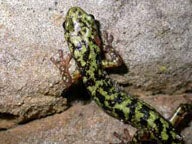SCIENTIFIC NAME:
Aneides aeneus (Cope and Packard)
OTHER NAMES:
None.
STATUS:
Rare to uncommon in Appalachian Plateau and Fall Line Hills and Transition Hills of extreme northwestern Alabama. Populations thought to have declined throughout. HIGH CONSERVATION CONCERN.
DESCRIPTION:
A medium-sized (max. = 140 mm [5.5 in.] total length) plethodontid salamander. Head dorso-ventrally flattened and broad; in adults, broader than body. Nasolabial grooves present, and 14 or 15 costal grooves prominent. Toes end in distinctly squared toe pads. Webbing between digits varies from light to moderate. Tail rounded and the same size or slightly longer than rest of body. Dorsum dark with metallic greenish or yellow green mottling, resembling the color of lichens on tree bark or wet rock. Venter light-colored and generally immaculate (Mount 1975, Petranka 1998). Reproductive males have a mental (chin) gland lacking in females.
DISTRIBUTION:
Majority includes parts of the Allegheny Plateau and the Blue Ridge Province. A disjunct from the main distribution extends from western North Carolina through western South Carolina, and into northwestern Georgia. In northeastern Alabama, restricted to the Appalachian Plateau. In northwestern Alabama, restricted to scattered populations in the Fall Line Hills (Mount 1975). Possibly three chromosomal races exist: a northern group distributed from Pennsylvania and West Virginia through Kentucky (Sessions and Kezer 1987); a southern group distributed through southern Kentucky and northern Alabama (op. cit.), and a group in southeastern Tennessee (Morescalchi 1975). The disjunct populations of the Carolinas and Georgia appear related to the northern group, whereas the Mississippi populations are probably related to remainder of southern group.
HABITAT:
Crevices in cliff faces, rock outcrops, and caves in shaded, mesic hardwood forests. Crevices are moist, but not permanently wet. Occasionally found under fallen tree bark, or in rotting logs and stumps that probably feature lower temperatures and higher relative humidity.
LIFE HISTORY AND ECOLOGY:
Mating may occur May through September throughout distribution, with no apparent latitudinal pattern in timing of oviposition. Eggs laid in crevices, or under the bark of rotting logs. Those laid in crevices usually suspended from roof of crevice by several strands of mucus. Clutches laid in June or July; hatch in late August through late October (Gordon 1952, 1967; Mount 1975). Clutch size varies from 10 to 27 eggs per clutch (Bishop 1943, Petranka 1998). Females attend eggs, and hatching success closely linked to female attendance (Snyder 1973). Upon hatching, juveniles disperse from crevices and find crevices with moss beds. At night, adults venture out from crevice retreats and climb vertical rock faces, presumably in search of food. During the day, retreat to shallow crevices where they can occasionally be viewed via flashlight. In winter, retreat to deeper crevices to avoid freezing. Little diet data available; however, the few studies conducted indicate a wide variety of invertebrates are eaten. Ring-necked snakes are known predators of eggs and adults.
BASIS FOR STATUS CLASSIFICATION:
A habitat specialist throughout its distribution. Since Alabama represents the southern limits of its distribution, southern populations may be more sensitive to habitat alteration. Much of former habitat in Alabama has been strip-mined. River impoundments may have inundated bluffs that previously supported populations. Silvicultural practices such as clear-cutting may change microhabitats by raising temperatures and/or lowering relative humidity to the point where some sites may no longer support populations. Replacement of hardwoods with faster growing pines may further alter habitat making it unsuitable. Human-induced chemical threats include acid precipitation, heavy metals, herbicides, and pesticides. The latter three may negatively impact species through exposure via the food chain or through contamination of groundwater. Overcollecting at certain historic sites may contribute to local extirpations. Recent surveys have produced varying results. Some historic sites still support healthy populations, whereas no salamanders were found at other sites. These studies are confounded by secretive behavior of species; however, these salamanders seem to be fairly inquisitive. After initially surveying a site, a second investigator often observed them in crevices just searched. Recent reports of local extirpations come from throughout the species’ distribution. This species is listed as Endangered in Indiana, Ohio, Maryland, Mississippi, and North Carolina; Threatened in Pennsylvania; Protected in Alabama and Georgia; Rare in Virginia; and Special Concern in South Carolina and West Virginia. Kentucky and Tennessee populations are not listed.
Author: George R. Cline






